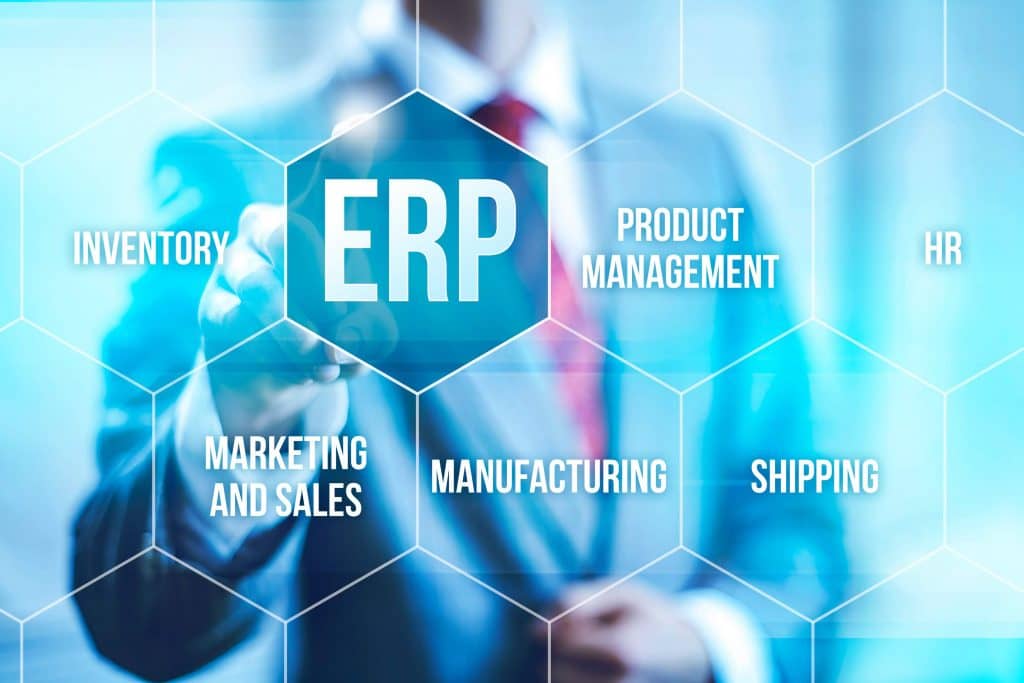ERP Software: Rethinking How Business Are Run and Managed
ERP stands for Enterprise resource planning and, for all practical purposes, is a type of a software application which helps businesses efficiently manage core processes.

By Iffy Kukkoo
23 Mar, 2017
What Is ERP?
ERP stands for Enterprise resource planning and, for all practical purposes, is a type of a software application which helps businesses efficiently manage core processes. But, ERP is so much more, and this article intends to show how much. For now, let’s just say that it shouldn’t be considered an overstatement the claim that, combined with a CRM solution and content management system, a good ERP completes the holy trinity of successful business, i.e. the underlying technology behind any company striving to become great. Yours should be no exception.
Today having an ERP system is not a luxury but a necessity. Having a properly implemented ERP system and a fully trained workforce that knows how to use the system in the best possible way is a must for survival in this brutally competitive world.
Alexis Leon, ERP Demystified.
An ERP software streamlines and automates business processes, accumulating, storing, managing and interpreting data from many different business activities, thus making the single unified stream of real-time information not only possible, but indispensable. With ERP, managers and business executives are able to follow the ups and downs of their companies’ processes separately and concurrently at the same time – in a way which makes the information provided both ready for evaluation and meaningful in terms of future actions and developments. This results in a competitive advantage, which usually provides businesses with the much-needed edge over competitors.
A software is an ERP software only if it provides users with a combination of features as distinct and as important as modularity, flexibility, accessibility and ”˜best business practices’. This last feature is particularly important since it means that a business using ERP software uses techniques superior to any other alternatives, which, in turn, indicates that implementing ERP leads to dramatically reducing risks, costs, and training times.
Example Case: What Does ERP Do In Practice?
Suppose a person has an idea for a great product. As is usually the case, he goes from man to man promoting his idea, takes one or two advices from more experienced businessmen, checks as much as he can if the market conditions are suitable for his product at that moment, and, lastly, develops a rough sketch of the final product. You would think that that’s it, right? Guess again.
Most people do just enough to reach this phase. But, they are usually not even prepared for the next one: actually starting the business. And this is where an ERP software comes in handy: it does all the hard and tiring work for you. By automating most of the repeating tasks necessary to produce and place the product on the market – from controlling and overseeing inventory management to making sure the product reaches the market at the right moment – an ERP software should leave no stone unturned.
ERP checks in a click whether the raw materials necessary for manufacturing the product are in stock or whether they need to be ordered. It examines delays, errors and price surges in real-time. It stores all the essential information at one place. It constantly oversees the product inventory against new demands, informing you whenever the product’s inventory is insufficient to fulfil the demand.
It’s not that an ERP software does something ten men can’t manage by themselves. But, it does it alone, much faster and streamlined, and makes no mistakes. Previously, all these calculations required tons of administrative work resulting in increased costs and compromising efficiency and profit margins. ERP handles data in a way which makes everything easier. Since it’s constantly and automatically updated, whenever something unpredictable happens, company executives can effortlessly make changes and modifications. Timely and superior.
Advantages of Using ERP Software
ERP is a sort of an umbrella-term. Even before its popularization, people were able to do many of the previously listed tasks automatically, but never in this centralized manner. That’s why an ERP software is your best all-in-one solution, combining many diverse standalone applications in a single unified database, e.g. finance, customer relationship management, manufacturing warehouse management, supply chain management, and logistics.
To put it in layman terms: since it houses so many seemingly incompatible business processes, an ERP software makes it possible for managers to see the big picture at all times. And this is what makes the difference: only managers who are able to see the big picture are able to make informed decisions about their company. Otherwise, how would you know if improving one of the processes in your company means the same for all the other?
With ERP, instead of having to spend so much time and energy just looking for important information, managers are able to immediately use all the relevant data about orders, deliveries, inventories, profits, losses, employees, etc. available to them in no more than few clicks. What’s more important, ERP makes possible for other employees to see some of the data as well, making interdepartmental communication much more accurate and effective.
ERP is commonly misperceived as a computer system. Not so. It’s a people system made possible by the computer software and hardware.
Thomas Wallace & Michael Kremzar, ERP: Making It Happen, p. 25
Implementing ERP: Two Downsides
Implementing an ERP Software is a complicated task which necessities both money and time. Even small and mid-size companies should be ready to spend thousands and thousands of dollars. The cost for a good ERP software for a large company can reach up to million dollars.
The prices can vary, but their amount owes much to the fact that each ERP software is specifically tailored to the respective business’ needs. Setting it up alone may take anywhere between 30 and 60 days. Setting up the necessary servers and equipment for the ERP software to function properly is another contributing factor to its high price: integrating different business areas requires from the ERP software to handle high load of data which would be impossible in the absence of compatible hardware.
What Makes ERP Worth the Investment
Just because an ERP software requires high funding effort, a lot of patience and strategic planning, in addition to the time you never have, does not mean that it is not worth it. After all, if it was so, a whole host of companies and businesses, ranging from local firms to multinational corporations, would not be using it at the moment. As is usually the case, good investments make for great investment returns. And an ERP software is more than a good investment.
Information and intelligence are half of the equation. The other half is flexible and adaptive production processes that can swiftly respond to threats and/or opportunities. This requires automation, real-time proficiency, and active fast-paced process improvement programs, managed by real-time information.
Wayne L. Staley, Founder, “Affinity Systems LLC”
However, what if you are a small or a mid-size business and you know that you need ERP badly, but your profits are not high enough to cover its implementation. Well, developers have found a way to help you: it’s called Software as a Service (or SaaS for short) and it’s a cloud-based solution which removes many of the obstacles associated with traditional ERP software setups.
ERP in The Cloud
Cloud-based ERP has helped many small and mid-size businesses finally see the advantages of using an ERP software. According to a recent meta-study, of the 87% of businesses who have adopted cloud-based ERP services within the last year, about half expresses regrets over not adopting it sooner. In addition, 47% of organizations are currently planning to move their core ERP systems to the cloud within five years, 26% of them planning to move within three years.
The reason is simple: cloud-based ERP is the best solution as far as small businesses are concerned. For one, buying and setting up equipment on the premise is not required. This saves the tedious task (not to mention the money) of maintaining the equipment and hiring people to manage it.
And since there is also no need for installing on-premise servers, the upfront cost is dramatically lower and the time necessary to set up the ERP software exponentially shorter. To use cloud-based ERP, in fact, business owners are only required to pay a monthly fee and they can readily take advantage of the services provided by the respective ERP software vendor.
The ERP software works in the cloud, meaning on servers hosted by some of the largest companies in the world (Microsoft, Amazon). It would be an understatement to say it’s stable at all times. So, the only prerequisite is a stable internet connection, and we guess you’re not a successful business if you already don’t have one.
Everything else – installation, maintenance and security – is taken care of by the ERP software provider. And, it doesn’t matter if you prefer Azure, AWS or a third SaaS provider, you just need to contact us and we’ll help you learn even more about cloud-based ERP, guiding you step-by-step to the best decision you’ve ever made for the success of your business.
Conclusion
Because, ERP is nothing less: an all-in-one software solution for all your business needs, it’s a way of integrating core business processes and managing them efficiently, effectively and in real-time.
However, it’s also a pretty time-consuming and expensive investment, especially for a small or a mid-size company. Cloud-based ERP is the best way to tackle this problem. In a nutshell, it means implementing ERP remotely, by using the servers and resources of the ERP vendor. It requires no more than an internet connection and a monthly fee and, if used correctly, it should dramatically decrease both time and costs, in addition to returning investments within no more than a few months.
Cloud-based ERP has also two other often-overlooked advantages: it is risk-free (you just need to cancel the subscription if it doesn’t work for you) and easily scalable (if your business is successful, you won’t need to buy and set up new servers: you’ll just upgrade the package). Because of this, even large companies are currently rethinking their ERP strategy.
So, why shouldn’t you?
 Posted By: Iffy KukkooResident Editor-In-Chief
Posted By: Iffy KukkooResident Editor-In-ChiefIffy is our exclusive resident technology newshound editor, relentlessly exploring the beauties of the world from a 4th dimensional viewpoint. When not crafting, editing or publishing our IT content, she spends most of her time helping people understand life and its basic principles. You know, the little things around you, that you've failed to grasp each day.
Dee.ie IT blog has updates on IT Consultancy, IT Contractors and Software Development related posts, on how your business can be managed effectively using technology.
Feel free to read more and or reach out to share your thoughts, feelings and input on our articles, our team would love to hear from you!
 Have a Question or Need an Answer? Ask our Live Chat and we will include it in our FAQ’s to make things easier for others
Have a Question or Need an Answer? Ask our Live Chat and we will include it in our FAQ’s to make things easier for others
We use cookies on this site to enhance your user experience.
For a complete overview of all cookies used, please see cookie settings.
Manage Cookie Preferences
More info, see the cookies and similar technologies section of the Privacy Statement
Required
We use required cookies to perform essential website functions. For example, they're used to log you in, save your language preferences, provide a shopping basket experience, improve performance, route traffic between web servers, detect the size of your screen, determine page load times, improve user experience and for audience measurement. These cookies are necessary for our websites to work.
Analytics
We allow third parties to use analytics cookies to understand how you use our websites so we can make them better and the third parties can develop and improve their products, which they may use on websites that are not owned or operated by AuditMyIT. For example, they're used to gather information about the pages you visit and how many clicks you need to accomplish a task.





